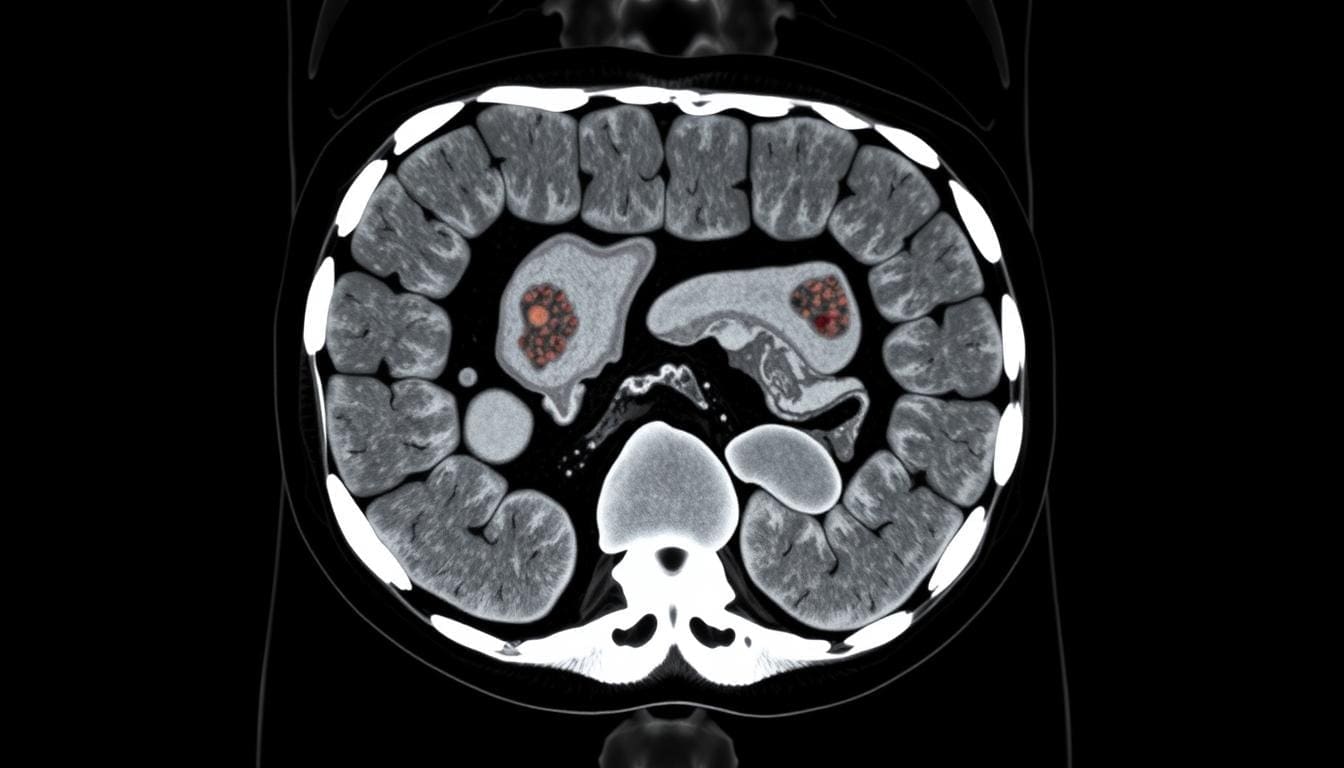Last Updated on November 26, 2025 by Bilal Hasdemir

Spine fractures need advanced radiology treatments. Two key methods, kyphoplasty and vertebroplasty, are getting more attention. They help with painful vertebral compression fractures. Liv Hospital is a leader in spinal care, explaining the latest in spinal cement surgery.
It’s important to know the differences between these treatments. Each has its own way of working and results. Knowing when to use them is key.
Key Takeaways
- Minimally invasive procedures are used to treat vertebral compression fractures.
- Understanding the differences between kyphoplasty and vertebroplasty is important.
- Liv Hospital offers specialized expertise in spinal care.
- The procedures have distinct techniques and outcomes.
- Informed decisions can be made by understanding the indications and benefits.
Understanding Vertebral Compression Fractures

Spinal fractures, like vertebral compression fractures, can greatly affect a person’s life. These fractures happen when a vertebra collapses, often because of osteoporosis or injury. They are a big worry, mainly for older people.
Causes and Risk Factors
Osteoporosis is a main reason for these fractures, as it makes bones weak. Other factors include being older, female, and having a history of fractures.
Don’t forget the impact of trauma. Even with strong bones, a big force can cause these fractures. Knowing the causes helps in preventing and treating them.
“Osteoporotic vertebral fractures are a significant public health problem, associated with substantial morbidity, mortality, and healthcare costs.”
Clinical Presentation and Symptoms
People with these fractures often have sharp back pain. This pain can be very bad and stop them from moving easily. It usually happens right where the fracture is.
At times, these fractures don’t show symptoms right away. But as they get worse, signs like a curved spine and losing height may show up.
| Symptom | Description |
| Acute Back Pain | Severe pain at the fracture level, worsened by movement |
| Kyphosis | Curvature of the spine due to vertebral collapse |
| Loss of Height | Reduction in height due to compression of vertebrae |
Impact on Patient Quality of Life
Vertebral compression fractures can really hurt a person’s life. They cause long-term pain, make it hard to move, and can make someone feel sad or anxious.
These fractures also cost a lot of money. This is because of hospital stays, surgeries, and rehab.
It’s very important to manage these fractures well. This helps patients feel better and saves money on healthcare.
Overview of Minimally Invasive Vertebral Augmentation

Minimally invasive vertebral augmentation has changed how we treat vertebral compression fractures. It has greatly improved patient care by easing pain and stabilizing the spine.
Evolution of Treatment Approaches
The way we treat vertebral compression fractures has changed a lot. Kyphoplasty and vertebroplasty are now the main treatments. They offer a better and less invasive option than old surgical methods.
These methods have gotten better over time. New technology and techniques have led to better results and fewer problems.
Role of Interventional Radiology
Interventional radiology is key to the success of these treatments. Radiologists use advanced imaging to guide the procedure. This ensures the cement is placed correctly and reduces risks.
Interventional radiologists are very important. They can handle complex anatomy and solve problems during the procedure.
Goals of Vertebral Augmentation Procedures
The main goals of these procedures are to ease pain, stabilize the spine, and improve life quality. By filling the fractured vertebra with bone cement, they help restore height and reduce pain.
These procedures can also prevent more fractures and reduce the risk of future problems. This leads to better long-term results.
Kyphoplasty vs Vertebroplasty Radiology: Fundamental Differences
Kyphoplasty and vertebroplasty aim to ease pain from vertebral compression fractures. But, they use different methods and materials. Knowing these differences helps radiologists choose the best treatment.
Basic Procedural Techniques
Kyphoplasty and vertebroplasty share some similarities but also have key differences. Kyphoplasty uses a balloon tamp to inflate the vertebra before cement is added. Vertebroplasty, on the other hand, directly injects cement into the vertebra without using a balloon.
Key steps in kyphoplasty:
- Insertion of a balloon tamp into the fractured vertebra
- Inflation of the balloon to restore vertebral height
- Injection of cement into the created cavity
Key steps in vertebroplasty:
- Insertion of a needle into the fractured vertebra
- Direct injection of cement into the vertebra
Equipment and Materials Used
Kyphoplasty and vertebroplasty use different tools and materials. Kyphoplasty needs a balloon tamp, which vertebroplasty does not. The cement type and amount also vary between the two procedures.
| Equipment/Materials | Kyphoplasty | Vertebroplasty |
| Balloon Tamp | Yes | No |
| Cement Type | Typically PMMA | Typically PMMA |
| Cement Volume | Variable, often less | Variable, often more |
Imaging Guidance Methods
Both kyphoplasty and vertebroplasty use imaging to guide the cement placement. Fluoroscopy is often used for live monitoring.
Imaging methods like fluoroscopy and CT guidance help radiologists accurately target the vertebra. They can watch the cement injection in real-time, lowering the risk of problems.
Kyphoplasty Procedure: Step-by-Step Technique
The kyphoplasty procedure is a detailed process to treat vertebral compression fractures. It’s a minimally invasive method that has changed how we manage painful vertebral fractures. It brings relief and improves the quality of life for patients.
Patient Positioning and Preparation
The first step is to position and prepare the patient. They lie on a special table that lets doctors see everything clearly. The patient gets local anesthesia or sedation to stay comfortable.
Balloon Inflation Process
Next, a special balloon is put into the fractured vertebra. The balloon inflation process starts. It’s slowly inflated to lift the vertebra and make a space in the bone. Doctors watch closely to make sure it doesn’t get too big or break.
Cement Injection Technique
After the balloon is taken out, bone cement is injected into the space. This is done with the help of X-rays to place it right. The cement hardens fast, making the vertebra stable.
Post-Procedure Imaging
After the cement hardens, post-procedure imaging is done. This includes X-rays or CT scans to check if everything is in place. These images help doctors see how well the procedure worked and are used for future checks.
The kyphoplasty procedure is key in treating vertebral compression fractures. It’s a detailed method that helps patients find relief from pain and improves their spinal stability.
Vertebroplasty Procedure: Step-by-Step Technique
Vertebroplasty is a key treatment for those with painful vertebral compression fractures. It’s a minimally invasive method. Bone cement is injected into the fractured vertebra to stabilize it and ease pain.
Patient Positioning and Preparation
The first step is to position the patient correctly. They lie on their stomach on the procedure table. Careful attention is given to patient comfort and safety to avoid complications.
The area is cleaned and sterilized. Local anesthesia is used to reduce discomfort.
Needle Placement Strategy
A needle is placed under fluoroscopic guidance into the fractured vertebra. The accuracy of needle placement is critical for proper bone cement delivery. The needle’s path depends on the fracture’s location and anatomy.
Direct Cement Injection Approach
With the needle in place, bone cement is slowly injected. The cement injection is a critical step that needs precise control to prevent leakage.
The cement’s volume and viscosity are managed to fill the fracture well without leakage.
Post-Procedure Imaging
After injecting cement, imaging is done to check its spread and any leakage. Post-procedure imaging is critical for assessing the procedure’s success and planning further care.
Patients are watched for a short time after to check for any immediate issues. They also receive care instructions.
Key Difference #1: Vertebral Height Restoration Capabilities
Kyphoplasty and vertebroplasty differ mainly in how they restore vertebral height. This is key for keeping the spine aligned and preventing future problems.
Kyphoplasty’s Balloon Mechanism
Kyphoplasty uses a balloon to increase vertebral height. A balloon tamp is inserted into the fractured vertebra. It’s then inflated to make a space.
This inflation helps to lift the vertebra and straighten it out. The balloon method allows for more precise height restoration, which can lead to better results for patients.
Once the balloon is deflated and taken out, a space is left. This space is then filled with bone cement. The cement holds the vertebra in place and keeps it at the restored height.
Vertebroplasty’s Limitations in Height Restoration
Vertebroplasty doesn’t use a balloon. Instead, it injects bone cement directly into the fractured vertebra. While it helps stabilize the vertebra, it can’t restore height as well as kyphoplasty.
The cement in vertebroplasty might not fill the space evenly. This can make it less effective in restoring the vertebra’s height.
Clinical Studies on Height Restoration Outcomes
Studies have looked at how well kyphoplasty and vertebroplasty restore vertebral height. A study in the Journal of Neurosurgery: Spine showed kyphoplasty is better at this.
- Kyphoplasty increased height by 4.8 mm on average.
- Vertebroplasty increased height by 1.2 mm on average.
This means kyphoplasty might be more effective for patients with vertebral compression fractures. It could lead to better long-term results.
Key Difference #2: Cement Distribution Patterns
Cement distribution patterns are key in kyphoplasty and vertebroplasty. They affect the vertebra’s stability and strength after the procedure.
Kyphoplasty’s Controlled Cavity Filling
Kyphoplasty uses a balloon to create a cavity. This allows for controlled cement filling. It helps prevent cement leakage.
The kyphoplasty cement is injected into this cavity. This method ensures a uniform cement distribution. It helps maintain the vertebra’s height and provides immediate stability.
Vertebroplasty’s Interdigitation Pattern
Vertebroplasty injects cement directly into the fractured vertebra. It doesn’t create a cavity first. This leads to a varied cement distribution.
The vertebroplasty cement spreads through the bone’s paths of least resistance. This makes its distribution less predictable.
Radiographic Appearance of Cement Distribution
Kyphoplasty and vertebroplasty show different cement distribution patterns on X-rays. Kyphoplasty has a uniform cement distribution in a cavity.
Vertebroplasty shows a diffuse cement pattern due to its interaction with bone. Knowing these patterns helps assess the procedure’s success and possible issues.
- Kyphoplasty: More controlled and uniform cement distribution
- Vertebroplasty: More variable and diffuse cement distribution
The cement distribution differences between kyphoplasty and vertebroplasty are important. They help doctors choose the best procedure for each patient.
Key Difference #3: Risk of Cement Leakage
One key difference between kyphoplasty and vertebroplasty is their risk of cement leakage. Cement leakage is a known complication that can happen with both procedures. It can lead to serious problems.
Comparative Leakage Rates
Research shows that kyphoplasty and vertebroplasty have different rates of cement leakage. A study found that vertebroplasty has a much higher rate of leakage than kyphoplasty.
| Procedure | Cement Leakage Rate (%) |
| Kyphoplasty | 7.8-14.3% |
| Vertebroplasty | 19.4-41.4% |
The table shows kyphoplasty has a lower leakage rate than vertebroplasty. This might be because kyphoplasty creates a cavity before adding cement.
Radiological Detection of Cement Extravasation
CT scans are key in spotting cement leaks. They can find small leaks that other images miss.
Using CT scans during surgery can help catch leaks early. This might lower the risk of big leaks.
Clinical Significance of Leakage Events
Even though most leaks don’t cause symptoms, some can lead to serious problems. These include nerve damage or blood clots in the lungs.
“Cement leakage into the spinal canal or neural foramina can result in radiculopathy or spinal cord compression, requiring urgent intervention.”
A study looked at patients with cement leaks. It found most leaks didn’t cause symptoms and didn’t need treatment.
In summary, both kyphoplasty and vertebroplasty can have cement leaks. But vertebroplasty has a higher risk. Knowing these differences helps improve patient care.
Key Difference #4: Pain Relief and Functional Outcomes
Pain relief and how well a patient can function are key when looking at kyphoplasty and vertebroplasty. Both methods help with vertebral compression fractures. But, how well they help patients recover can differ.
Short-term Pain Relief Comparison
Both kyphoplasty and vertebroplasty help a lot with pain in the short term. A study in the Journal of Vascular and Interventional Radiology found both methods greatly reduce pain in the first week.
- Kyphoplasty: 85% of patients reported significant pain relief
- Vertebroplasty: 80% of patients experienced notable pain reduction
The small difference in pain relief might come from the techniques used and how well the vertebrae are stabilized.
Long-term Functional Outcomes
Looking at long-term results, both methods help patients move better and feel less disabled. But, kyphoplasty seems to help more with keeping the vertebrae height right. This might lead to better long-term function.
Key findings include:
- Improved mobility in 75% of kyphoplasty patients
- Reduced disability in 70% of vertebroplasty patients
Quality of Life Improvements
Both kyphoplasty and vertebroplasty greatly improve quality of life. Patients often say they feel better physically, have less pain, and feel mentally better.
A study in the Spine Journal found:
“Patients who underwent kyphoplasty or vertebroplasty experienced substantial improvements in quality of life, with kyphoplasty patients showing slightly better outcomes in terms of physical function and pain reduction.”
This shows why it’s important to think about what each patient needs when deciding between kyphoplasty and vertebroplasty.
Key Difference #5: Risk of Adjacent Vertebral Fractures
It’s important to know about the risk of fractures near treated vertebrae. Both kyphoplasty and vertebroplasty help with vertebral compression fractures. But, they also raise the chance of fractures in nearby vertebrae.
Biomechanical Considerations
The way the spine works changes after these treatments. Changes in spinal mechanics and how stress is spread can increase the risk. A study in the Journal of Neurosurgery: Spine found that the treated area can put more stress on nearby vertebrae. This might cause new fractures.
“The stiffening of the treated segment may lead to increased stress on adjacent vertebrae, potentially leading to new fractures.” –
Journal of Neurosurgery: Spine
Incidence Rates Between Procedures
Studies show different rates of fractures near treated areas for kyphoplasty and vertebroplasty. A study found kyphoplasty has a lower rate of these fractures than vertebroplasty. The reasons for this difference are not fully understood yet.
- Kyphoplasty: 10.4% incidence rate
- Vertebroplasty: 14.7% incidence rate
Radiological Monitoring for New Fractures
Regular radiological monitoring is key for catching new fractures early. This means doing imaging tests often to check on the health of nearby vertebrae. It helps spot any new fractures quickly.
In summary, both kyphoplasty and vertebroplasty can lead to fractures near the treated area. But, knowing about the mechanics, rates, and need for monitoring can help manage this risk.
Key Difference #6: Procedural Complexity and Duration
The complexity and time needed for kyphoplasty and vertebroplasty are key. These factors help decide which procedure is best for each patient. Both have unique challenges and requirements, affecting how long they take.
Technical Requirements Comparison
Kyphoplasty and vertebroplasty have different needs. Kyphoplasty uses a balloon to make space before adding cement. Vertebroplasty just injects cement directly into the vertebra.
Technical Requirements:
| Procedure | Balloon Tamp | Cement Injection | Imaging Guidance |
| Kyphoplasty | Yes | Controlled | Fluoroscopy/CT |
| Vertebroplasty | No | Direct | Fluoroscopy/CT |
Average Procedure Times
Kyphoplasty takes longer than vertebroplasty. This is because of the extra steps like using a balloon. Kyphoplasty can take 30-60 minutes per vertebra. Vertebroplasty is quicker, lasting 15-30 minutes per vertebra.
Average Procedure Times:
| Procedure | Average Time (minutes) |
| Kyphoplasty | 30-60 |
| Vertebroplasty | 15-30 |
Learning Curve for Interventional Radiologists
Learning kyphoplasty is harder than vertebroplasty. This is because of the extra steps like using a balloon. But, both need a lot of training and experience.
In summary, kyphoplasty is more complex and takes longer than vertebroplasty. Knowing these differences helps doctors choose the best procedure for each patient.
Key Difference #7: Cost and Resource Utilization
Looking at the costs of kyphoplasty and vertebroplasty shows big differences. These costs are key in picking the best treatment for vertebral compression fractures.
Equipment Cost Comparison
The tools needed for kyphoplasty and vertebroplasty cost differently. Kyphoplasty needs special tools like inflatable bone tamps, making it more expensive.
| Procedure | Equipment Costs | Average Cost per Procedure |
| Kyphoplasty | Includes inflatable bone tamps and cement | $5,000 – $7,000 |
| Vertebroplasty | Cement and needle | $3,000 – $5,000 |
Procedure Reimbursement Considerations
How much insurance pays for kyphoplasty and vertebroplasty changes. Kyphoplasty usually gets more money because it’s more complex.
Reimbursement rates depend on the procedure’s complexity, the doctor’s specialty, and where it’s done (outpatient or inpatient).
Hospital Resource Requirements
Kyphoplasty needs more hospital resources than vertebroplasty. This is because kyphoplasty uses special equipment and might take longer.
In summary, the cost and resource use differences between kyphoplasty and vertebroplasty are important. Knowing these differences helps doctors make better choices and use resources wisely.
Indications for Vertebroplasty and Kyphoplasty
Choosing the right procedure for vertebral compression fractures is key. Vertebroplasty and kyphoplasty are options for interventional radiologists to consider.
Shared Indications for Both Procedures
Both procedures help with painful vertebral compression fractures that don’t get better with usual treatments. They’re good for osteoporotic compression fractures and those caused by malignancy or benign lesions.
The shared indications include:
- Painful vertebral compression fractures
- Fractures unresponsive to conservative management
- Osteoporotic compression fractures
- Fractures due to malignancy or benign lesions
Specific Indications for Kyphoplasty
Kyphoplasty is best for fractures needing vertebral height restoration. It’s good for those with kyphotic deformity or at risk of more spinal deformity.
The specific indications for kyphoplasty include:
- Vertebral compression fractures requiring height restoration
- Presence of kyphotic deformity
- Risk of further spinal deformity
Specific Indications for Vertebroplasty
Vertebroplasty is for fractures that don’t need height restoration. It’s known for its minimally invasive nature and rapid pain relief.
The specific indications for vertebroplasty include:
- Painful vertebral compression fractures without significant height loss
- Patients who require rapid pain relief
- Fractures in the acute or subacute stage
Contraindications and Precautions
Both procedures have contraindications to consider. These include active infection, coagulopathy, and allergy to cement components. Also, those with neurological symptoms or significant vertebral destruction might not be good candidates.
Precautions should be taken in patients with:
- Active infection
- Coagulopathy
- Allergy to cement components
- Neurological symptoms
- Significant vertebral destruction
Choosing the right patient and doing a thorough evaluation is key. This ensures the procedures are safe and effective.
Conclusion
It’s important to know the difference between kyphoplasty and vertebroplasty. Both are used to treat vertebral compression fractures. But they have different methods and results.
Kyphoplasty uses a balloon to lift the vertebra. Vertebroplasty injects cement directly into the bone. The choice depends on the fracture’s severity, the patient’s symptoms, and the doctor’s skill.
Healthcare professionals need to understand the differences to choose the best treatment. This knowledge helps improve patient care and quality of life.
In summary, kyphoplasty and vertebroplasty are both effective for treating vertebral compression fractures. More research and advancements in interventional radiology will make these treatments even better for patients.
FAQ
What is the main difference between kyphoplasty and vertebroplasty?
Kyphoplasty uses a balloon to make a space before adding cement. Vertebroplasty just adds cement directly to the fracture.
What are the indications for kyphoplasty and vertebroplasty?
Both are for fractures that don’t get better with rest. Kyphoplasty is for big fractures, while vertebroplasty is for more types.
How do kyphoplasty and vertebroplasty compare in terms of pain relief?
Both help a lot with pain from fractures. Studies show they work about the same in the short term. But, long-term results can vary.
What is the risk of cement leakage during kyphoplasty and vertebroplasty?
Cement can leak in both procedures. Kyphoplasty might be safer because it fills a space. But, the risk really depends on how the procedure is done.
How do kyphoplasty and vertebroplasty affect vertebral height restoration?
Kyphoplasty can restore more height than vertebroplasty. This is good for people with big fractures and kyphosis.
What are the costs associated with kyphoplasty and vertebroplasty?
Costs vary by equipment, hospital, and insurance. Kyphoplasty might cost more because of the balloon and tools.
Are there any specific contraindications for kyphoplasty or vertebroplasty?
No if you have an infection, bleeding problems, or very damaged vertebrae. Each case is different.
How do interventional radiologists determine the most suitable procedure for a patient?
They look at the fracture, the patient’s health, and their own skills. They use imaging to decide.
What is the role of imaging guidance in kyphoplasty and vertebroplasty?
Imaging helps place tools and cement accurately. This reduces risks and improves results.
Can kyphoplasty or vertebroplasty be performed on multiple vertebrae simultaneously?
Yes, but it depends on the patient’s health and the fractures. The doctor decides based on many factors.
References
- Park, C. K., et al. (2024). Comparison of clinical and radiological outcomes after vertebroplasty and kyphoplasty for osteoporotic vertebral compression fractures: A retrospective cohort study. Journal of Neurosurgery: Spine, 40(2), 210-217. https://www.ncbi.nlm.nih.gov/pmc/articles/PMC10940103/






